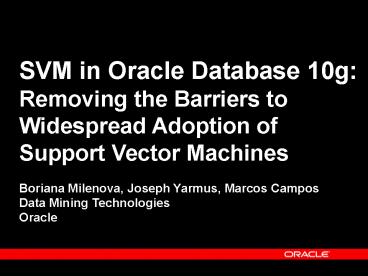SVM: Algorithms of Choice for Challenging Data PowerPoint PPT Presentation
1 / 31
Title: SVM: Algorithms of Choice for Challenging Data
1
SVM in Oracle Database 10g Removing the Barriers
to Widespread Adoption of Support Vector
Machines Boriana Milenova, Joseph Yarmus, Marcos
CamposData Mining Technologies Oracle
2
Overview
- Support Vector Machines fundamentals
- Hurdles to widespread SVM adoption
- Usability
- Scalability
- Oracles solutions for productizing SVM
3
Data Mining in RDBMS
- Growing importance of analytic technologies
- Large volumes of data need to be
processed/analyzed - Modern data mining techniques are robust and
offer high accuracy - Challenges of data mining
- Complex methodologies
- Computationally intensive
4
Why SVM?
- Powerful state-of-the-art classifier
- Strong theoretical foundations
- Vapnik-Chervonenkis (VC) theory
- Regularization properties
- Good generalization to novel data
- Algorithm of choice for challenging
high-dimensional data - Text, image, bioinformatics
5
Conceptual Simplicity
An SVM model defines a hyperplane in the feature
space in terms of coefficients (w) and a bias
term (b) Prediction
6
SVM Optimization Problem Linearly Separable Case
Minimize
, subject to
- Maximum separation between classes
- Dimensionality insensitive
- Sparse solution
- Single global minimum
- Solvable in polynomial time
7
Kernel Classifiers
- Transform data via non-linear mapping to an inner
product feature space - Gaussian, polynomial kernels
- Train a linear machine in the new feature space
8
SVM Soft Margin Optimization Non-Separable Case
Capacity parameter C trades off complexity and
empirical risk
x
x
subject to
9
SVM Regression
e
e-insensitive loss function
subject to
10
One-Class SVM
- Outlier detection
- Typical cases vs. outliers
- Discrimination between a known class and the
unknown universe of counterexamples
11
SVM in the Database
- Oracle Data Mining (ODM)
- Commercial SVM implementation in the database
- Product targets application developers and data
mining practitioners - Focuses on ease of use and efficiency
- Challenges
- Good out-of-the-box accuracy
- Good scalability
- large quantities of data, low memory
requirements, fast response time
12
SVM Accuracy User Impact
- Inexperienced users can get dramatically poor
results
Naive useraccuracy Expert useraccuracy
Astroparticle Physics 0.67 0.97
Bioinformatics 0.57 0.79
Vehicle 0.02 0.88
13
Tricks of the Trade for Improving SVM Accuracy
- Data preparation
- Outlier removal
- Scaling
- Categorical to numeric attribute recoding
- Parameter estimation (model selection)
- Grid search
- Cross-validation
- Heuristics
- Gradient descent optimization
14
Oracles Data Preparation Support
- Automatic data preparation
- Outlier removal
- Scaling
- Categorical to numeric attribute recoding
- Supported by
- dbms_data_mining_transform package
- Oracle Data Miner
15
Oracles On-the-Fly SVM Parameter Estimation
- Data-driven
- Low computational cost
- Ensure good generalization
- Avoid overfitting
- model is too complex and data is memorized
- Avoid underfitting
- model is not complex enough to capture the
underlying structure of the data
16
Classification Capacity Estimate
- Goal Allocate sufficient capacity to separate
typical examples - Pick m random examples per class
- Compute fi assuming a C
- Exclude noise (incorrect sign)
- Scale C, (non bounded sv)
- Order descending
- Select 90th percentile
17
Classification Standard Deviation Estimate
- Goal Estimate distance between classes
- Pick random pairs from opposite classes
- Measure distances
- Order descending
- Select 90th percentile
18
Classification Comparison
Naive user Grid search xval Oracle
Astroparticle Physics 0.67 0.97 0.97
Bioinformatics 0.57 0.85 0.84
Vehicle 0.02 0.88 0.71
19
Epsilon Estimate
- Goal estimate target noise by fitting
preliminary models - Pick small training and held-aside sets
- Train SVM model with
- Compute residuals on held-aside data
- Update
- Retrain
20
Regression Comparison
Grid searchRMSE Oracle RMSE
Boston housing 6.26 6.57
Computer activity 0.33 0.35
Pumadyn 0.02 0.02
21
SVM Scalability Issues
- Build scalability
- Quadratic scalability with number of records
- Feasible for small/medium datasets
- Scoring scalability
- Large model sizes (non-linear kernels) make
online scoring impractical
22
Scalability Improvements
- Popular build scalability techniques
- Chunking and decomposition
- Working set selection
- Kernel caching
- Shrinking
- Sparse data encoding
- Specialized linear model representation
- However, these standard techniques are usually
not sufficient
23
Oracles Additional Scalability Improvements
- Stratified sampling
- Classification and regression
- Single pass through the data
- Working set selection
- Smooth transitions between working sets
- Faster convergence
- Computationally efficient
24
Oracles Additional Scalability Improvements
(cont.)
- Reduced model size
- Specialized linear representation
- Active learning for non-linear kernels
- Construct a small initial model
- Select additional influential training records
- Retrain on the augmented training sample
- Exit when the maximum allowed model size is
reached
25
Build Scalability Results
26
Scoring Scalability Results
27
Oracle Scoring Time Breakdown
- Linear classification model
50K 1M 2M 4M
SVM scoring (sec) 18 37 71 150
Persistence (sec) 2 4 11 22
28
SVM Scoring as a SQL Operator
- Easy integration
- DML statements, subqueries, functional indexes
- Parallelism
- Small memory footprint
- Model cached in shared memory
- Pipelined operation
- SELECT id, PREDICTION(svm_model_1 USING )
- FROM user_data
- WHERE PREDICTION_PROBABILITY(svm_model_2,
- 'target_val USING ) gt 0.5
29
Conclusions
- Implementing an SVM tool with an adequate level
of usability and performance is a non-trivial
task - Oracles SVM implementation allows database users
with little data mining expertise to achieve
reasonable out-of-the-box results - Corroborated by independent evaluations by the
University of Rhode Island and the University of
Genoa
30
Final Note
- SVM is available in Oracle 10g database
- Implementation details described here refer to
Oracle 10g Release 2 - JAVA (J2EE) and PL/SQL APIs
- Oracle Data Miner GUI
- Oracles SVM has been integrated by ISVs
- SPSS (Clementine)
- InforSense KDE Oracle Edition
31
(No Transcript)

